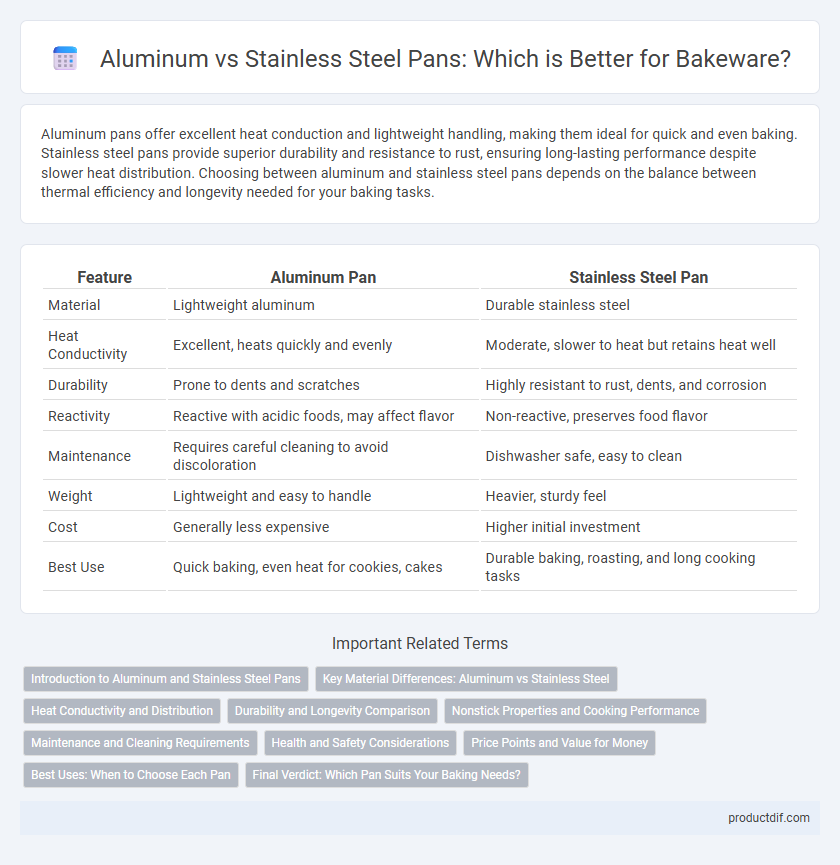Aluminum pans offer excellent heat conduction and lightweight handling, making them ideal for quick and even baking. Stainless steel pans provide superior durability and resistance to rust, ensuring long-lasting performance despite slower heat distribution. Choosing between aluminum and stainless steel pans depends on the balance between thermal efficiency and longevity needed for your baking tasks.
Table of Comparison
| Feature | Aluminum Pan | Stainless Steel Pan |
|---|---|---|
| Material | Lightweight aluminum | Durable stainless steel |
| Heat Conductivity | Excellent, heats quickly and evenly | Moderate, slower to heat but retains heat well |
| Durability | Prone to dents and scratches | Highly resistant to rust, dents, and corrosion |
| Reactivity | Reactive with acidic foods, may affect flavor | Non-reactive, preserves food flavor |
| Maintenance | Requires careful cleaning to avoid discoloration | Dishwasher safe, easy to clean |
| Weight | Lightweight and easy to handle | Heavier, sturdy feel |
| Cost | Generally less expensive | Higher initial investment |
| Best Use | Quick baking, even heat for cookies, cakes | Durable baking, roasting, and long cooking tasks |
Introduction to Aluminum and Stainless Steel Pans
Aluminum pans offer excellent heat conductivity and lightweight properties, making them ideal for even baking and quick temperature adjustments. Stainless steel pans provide superior durability, corrosion resistance, and a non-reactive surface, ensuring long-lasting performance without altering food flavors. Both materials serve distinct baking needs, with aluminum favored for heat responsiveness and stainless steel valued for its strength and maintenance ease.
Key Material Differences: Aluminum vs Stainless Steel
Aluminum pans offer excellent heat conductivity and lightweight handling, allowing for rapid and even baking, whereas stainless steel pans provide superior durability and resistance to corrosion, ensuring longevity under frequent use. Aluminum's reactive nature can lead to discoloration or off-flavors with acidic ingredients, while stainless steel's non-reactive surface maintains flavor integrity and is often preferred for recipes requiring high oven temperatures. Choosing between aluminum and stainless steel bakeware depends on prioritizing heat performance versus durability and chemical resistance in baking applications.
Heat Conductivity and Distribution
Aluminum pans offer superior heat conductivity, allowing for faster and more even heat distribution during baking. Stainless steel pans have lower thermal conductivity, which can result in slower and less uniform heating but provide greater durability and resistance to warping. Choosing aluminum ensures quick temperature response and consistent baking results, whereas stainless steel offers long-term resilience with slightly compromised heat performance.
Durability and Longevity Comparison
Aluminum pans offer excellent heat conduction but are prone to warping and scratching, reducing their durability over time. Stainless steel pans, known for their robust construction, resist corrosion and maintain structural integrity, providing long-lasting performance. Choosing stainless steel enhances longevity due to its superior strength and resilience against everyday wear in the kitchen.
Nonstick Properties and Cooking Performance
Aluminum pans offer superior nonstick properties due to their smooth surface and excellent heat conductivity, ensuring even cooking and easy food release. Stainless steel pans, while less naturally nonstick, provide better durability and resistance to warping, making them ideal for high-heat cooking and searing. Choosing between aluminum and stainless steel bakeware depends on whether nonstick convenience or cooking performance under intense heat is the priority.
Maintenance and Cleaning Requirements
Aluminum pans require gentle cleaning with mild detergents to prevent surface damage and may discolor with prolonged exposure to acidic foods, while stainless steel pans offer superior resistance to stains and corrosion, allowing for more aggressive scrubbing without harm. Aluminum pans often need seasoning or protective coatings to maintain performance and prevent oxidation, whereas stainless steel is inherently non-reactive and easy to maintain with regular dishwashing. Stainless steel pans typically withstand dishwasher cycles, contrasting with aluminum pans that can warp or dull when exposed to harsh dishwasher detergents.
Health and Safety Considerations
Aluminum pans may react with acidic or alkaline foods, potentially leading to metal leaching and altering food taste, while stainless steel pans are non-reactive and provide a safer cooking surface. Stainless steel offers superior durability and resistance to rust and corrosion, minimizing the risk of contamination that can occur with damaged aluminum surfaces. Choosing stainless steel bakeware reduces exposure to aluminum, which some studies associate with health concerns, whereas coated aluminum pans mitigate this risk but require careful maintenance to avoid damaging the protective layer.
Price Points and Value for Money
Aluminum pans generally cost less than stainless steel pans, making them an affordable choice for budget-conscious bakers seeking efficient heat conduction. Stainless steel pans offer greater durability and resistance to rust and warping, providing better long-term value despite their higher initial price. Choosing between aluminum and stainless steel bakeware depends on balancing upfront cost with durability and performance to maximize overall value for money.
Best Uses: When to Choose Each Pan
Aluminum pans are ideal for baking tasks that require even heat distribution and quick temperature adjustments, such as cakes, cookies, and delicate pastries. Stainless steel pans excel in roasting and broiling due to their durability and resistance to warping under high heat. Choose aluminum for consistent baking results and stainless steel when durability and heat tolerance are priorities.
Final Verdict: Which Pan Suits Your Baking Needs?
Aluminum pans offer excellent heat conductivity and even baking, making them ideal for recipes requiring precise temperature control, such as cakes and cookies. Stainless steel pans provide superior durability and resistance to warping, perfect for high-temperature baking and heavier dishes like roasts or casseroles. Choosing between aluminum and stainless steel pans depends on your baking priorities: aluminum for consistent heat distribution and stainless steel for longevity and structural strength.
Aluminum Pan vs Stainless Steel Pan Infographic

 productdif.com
productdif.com